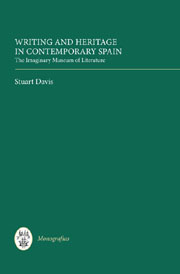Book contents
- Frontmatter
- Contents
- Acknowledgements
- Introduction
- 1 Presenting the Museum
- 2 Never-ending Story: Canon Fever
- 3 Working Models, Model (Re)Workings: Goytisolo and Cervantes
- 4 The Authoritative Gaze: Cristina Peri Rossi
- 5 Generations Apart? The ‘Generation X’ in Spanish Literature
- Conclusion: What do we do with the Gifts of the Past?
- Works Cited
- Index
5 - Generations Apart? The ‘Generation X’ in Spanish Literature
Published online by Cambridge University Press: 05 February 2013
- Frontmatter
- Contents
- Acknowledgements
- Introduction
- 1 Presenting the Museum
- 2 Never-ending Story: Canon Fever
- 3 Working Models, Model (Re)Workings: Goytisolo and Cervantes
- 4 The Authoritative Gaze: Cristina Peri Rossi
- 5 Generations Apart? The ‘Generation X’ in Spanish Literature
- Conclusion: What do we do with the Gifts of the Past?
- Works Cited
- Index
Summary
When a building is as good as that one, fuck the art!
Philip JohnsonEl viejo comienza a soltar el rollo de la guerra. Habla de cómo su madre se murió de hambre, de cómo su padre le dieron el paseo los rojos, de cómo fumaba las colillas que recogía del suelo y hacía las colas de aprovisionamiento. Las viejas historias del pasado. El pasado es siempre aburrido.
José Ángel MañasVisit: Guggenheim Bilbao Museoa
While in the previous chapter we witnessed the creation of an imaginary museum where the contents were the focus of our attention, in this chapter we attend to an example of a museum, and subsequently a literary generation, where location and façade take primacy over the content. The Solomon R. Guggenheim Foundation's museum in Bilbao, opened in October 1997, is housed in what is undoubtedly a famous and iconic building, not only for its striking design by the celebrated architect, Frank O. Gehry, but also for its role in rejuvenating both the city in which it stands and also museum practices.
Any physical view of the Guggenheim Bilbao Museoa (GBM) will be partial. Of course, no (museum) building can be seen from all its perspectives simultaneously, and many have multiple entrance points, like the Prado, but nothing creates the spectacle of beholding the museum quite like the Guggenheim.
- Type
- Chapter
- Information
- Writing and Heritage in Contemporary SpainThe Imaginary Museum of Literature, pp. 146 - 178Publisher: Boydell & BrewerPrint publication year: 2012



